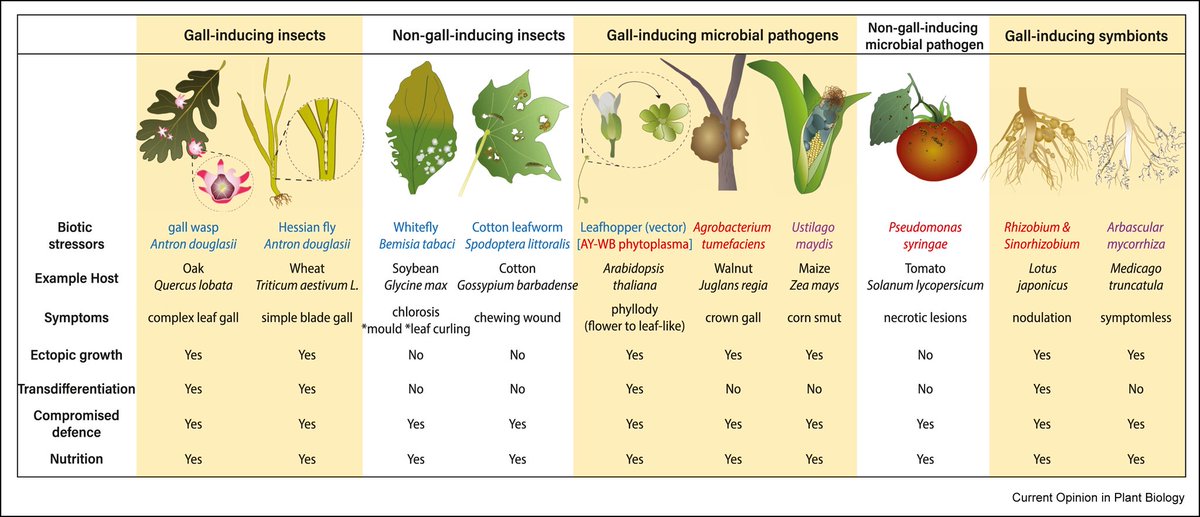
Yan Ma
@TerezaYan
PI at GMI, diving into the mysterious insect-induced galls, new gall model in Arabidopsis will provide fresh angle for defense & developmental signalling.
First Ma lab #GMI paper is now online! It‘s a mini-review on insect-induced plant #galls —their coolness and research potential! Plant galls induced by insects: Coordinated developmental reprogrammin... sciencedirect.com/science/articl…

The discovery of the resistosome was a milestone in plant immunity. Here, we identify a kinase that phosphorylates the NLR, and reveal how this kinase regulates resistosome assembly to fine-tune immune responses. rdcu.be/eeuCr
Outer Membrane Vesicles (OMVs) Produced by Plant Beneficial Rhizospheric Bacteria Enter Root Epidermal Cells biorxiv.org/content/10.110… #biorxiv_plants
Excited to preprint work mainly by former postdocs Li Feng, Yingnan Hou @Cerhou, and the phylogenomics genius @amiralito_ @TheSainsburyLab. We found a plant defense gene family enabling pathogen gene silencing & explored engineering this pathway to boost disease resistance!
A conserved small RNA-generating gene cluster undergoes sequence diversification and contributes to plant immunity biorxiv.org/content/10.110… #biorxiv_plants
We recently wrote two Preview articles of exciting MPMI papers in Mol Cell and Dev Cell. Two surprising cases showing different ways to regulate immune receptors in plants -- the cell surface LRR-RK, SYR1 and the intracellular NLR DM2 Short summaries below 🧵🌱 #2025ISMPMI
It was a great session indeed.
Fantastic talks from 5 speakers showcasing diverse approaches and biological questions to explore MPMI across space and time! Loved seeing the discussions continue well beyond the session. Huge thanks to the speakers and everyone who attended the session! #2025ISMPMI
Scalable emulation of protein equilibrium ensembles with generative deep learning | Science science.org/doi/10.1126/sc…
#2025ISMPMI @Tolga_Bzkrt introduces the effector and immune processes occurring at Phytophthora haustoria. The helper NRC4 localises to haustoria and upon activation inserts itself into the extrahaustorial membrane forming punctuate foci. It seems activated NLRs beep annoyingly.
Finally, the nucleus shrinks and releases its contents into the cytoplasm. The hypersensitive cell death concludes with the collapse of the tonoplast and plasma membrane systems.
Poltergeist-Like 2 (PLL2)-dependent activation of herbivore defence distinguishes systemin from other immune signalling pathways | Nature Plants nature.com/articles/s4147…
AlphaFold models of host-pathogen interactions elucidate the prevalence and structural modes of molecular mimicry 1.This study utilizes AlphaFold models to predict the structures of host-pathogen protein-protein interactions (PPIs), shedding light on the prevalence and…
Have you ever thought about inflating tissues? Or maybe quickly deflating those inflated tissues? New #EpithelialMechanics pre-print: doi.org/10.1101/2025.0… 🧵with pressure control, multiscale buckling, patterned wrinkling
Single-cell-resolved calcium and organelle dynamics in resistosome-mediated cell death biorxiv.org/content/10.110… #biorxiv_plants
Single-cell transcriptomics reveal how root tissues adapt to soil stress | Nature nature.com/articles/s4158…

11 things you should NOT say in high-pressure moments, And what strong leaders say instead:
Check out our new paper in @NatureBiotech sharing our latest kinase activity reporters! Led by former postdoc Michelle Frei, these reporters are based on HaloTag rather than an FP, for far-red imaging and superresolution! nature.com/articles/s4158…
Genomic and genetic insights into Mendel’s pea genes | Nature nature.com/articles/s4158…
It's finally out! On the activation of RRS1-R/RPS4 paired NLRs!! Thanks to @jonathandgjones for this opportunity to work on this project, and thanks to all the coauthors for their effort and support! Thread to follow @TheSainsburyLab @InstMolPlantSci
Recognition-dependent activation of the RRS1-R/RPS4 immune receptor complex biorxiv.org/content/10.110… #biorxiv_plants
“a genome-wide association study (GWAS) of 291 wheat varieties and integrated transcriptomic data to identify TaLAC129, a laccase (LAC)-encoding gene, as a critical negative regulator of AM colonization”
𝐍𝐞𝐰 𝐢𝐧 𝐓𝐏𝐉🌾 A laccase gene could be a promising breeding target 👉 *TaLAC129 is a negative regulator of arbuscular mycorrhizal symbiosis but enhanced the growth and yield of bread wheat* 📖doi.org/10.1111/tpj.70… by Zhong, Hui et al
ROS regulation of stigma papillae growth and maturation in Arabidopsis thaliana biorxiv.org/content/10.110… #biorxiv_plants